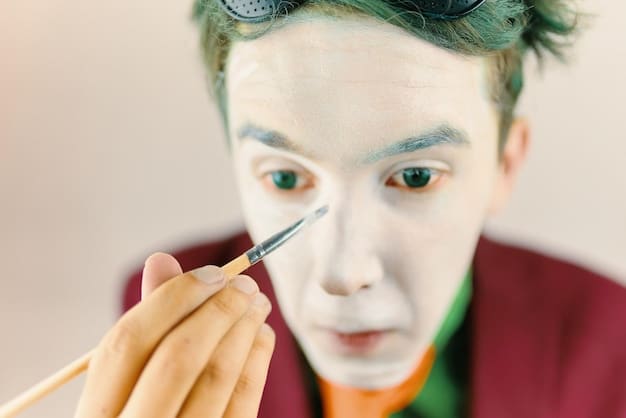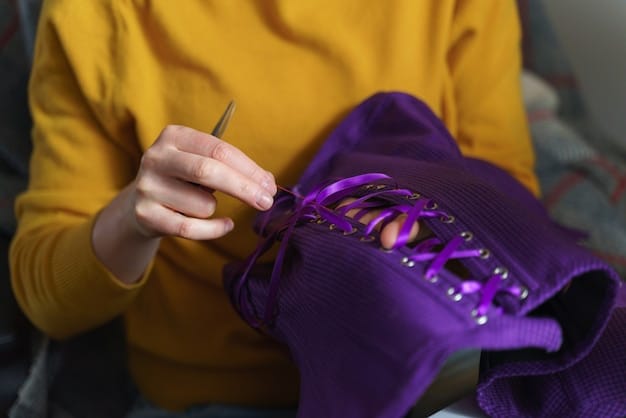The Ultimate Guide to Cosplay: Transforming into Your Favorite Characters

Cosplay, short for “costume play,” is a vibrant and immersive art form where fans embody their favorite characters through meticulously crafted costumes and performances, bringing fictional worlds to life.
Embark on an exciting journey into the world of cosplay, where imagination meets craftsmanship. This comprehensive guide will walk you through everything you need to know to transform into your beloved characters, from initial concept to stunning final reveal.
What is Cosplay and Why is it So Appealing?
Cosplay is more than just dressing up; it’s an art form, a hobby, and a community all rolled into one. It involves creating and wearing costumes to represent specific characters, often from anime, manga, video games, comic books, and movies.
The appeal of cosplay lies in several factors, including the opportunity to express creativity, connect with like-minded individuals, and pay homage to beloved characters. It’s a chance to step outside of everyday life and embody someone or something extraordinary.
The History of Cosplay
While the modern concept of cosplay is often associated with Japanese anime and manga, its roots can be traced back to early science fiction conventions and masquerade balls in the United States. Forrest J Ackerman, a science fiction fan and editor, is often credited with coining the word “costume play.”
Cosplay gained significant momentum in Japan during the 1980s with events like Comiket, a massive fan convention dedicated to self-published manga and other fan works. Over time, cosplay culture spread globally, evolving into the diverse and vibrant community we know today.
The Psychological Benefits of Cosplay
Beyond the creative expression and social connection, cosplay can also offer psychological benefits. Stepping into the shoes of a character can boost confidence, encourage self-expression, and provide a sense of empowerment. The process of creating a costume can also be a form of therapy, allowing individuals to focus on a tangible project and express their emotions through art.
- Boosting Confidence: Embodying a confident character allows you to feel more assertive.
- Encouraging Self-Expression: Cosplay provides a creative outlet to express your inner self.
- Providing a Sense of Empowerment: Transforming into a powerful character can be incredibly empowering.

In conclusion, cosplay is a multifaceted activity that blends artistic expression, social interaction, and personal growth. Whether you’re a seasoned cosplayer or just starting out, the world of cosplay offers endless opportunities for creativity, connection, and self-discovery.
Getting Started: Choosing Your First Character
Choosing your first character to cosplay can feel overwhelming. With so many options available, it’s important to consider a few key factors to ensure a successful and enjoyable experience.
Start by thinking about your favorite characters and the reasons why you’re drawn to them. Consider your skill level, budget, and the amount of time you’re willing to dedicate to the project. A simpler costume might be a better choice for your first cosplay.
Factors to Consider When Choosing a Character
When selecting a character, several factors should influence your decision. First, consider your personal connection to the character. Do you admire their personality, their story, or their design? Choosing a character you genuinely love will make the entire process more enjoyable.
Next, assess the complexity of the costume. Some characters have incredibly intricate outfits that require advanced sewing, crafting, and prop-making skills. If you’re new to cosplay, it’s best to start with something simpler. Finally, consider your budget. Some costumes can be quite expensive, especially if they require specialized materials or commissioned work.
Popular Characters for Beginner Cosplayers
Many characters are well-suited for beginner cosplayers due to their relatively simple costumes and readily available materials. Some popular choices include characters from anime like “My Hero Academia,” video games like “Animal Crossing,” and comic books like “Spider-Man.”
These characters often have recognizable designs that are easy to replicate without requiring advanced skills or expensive materials. Additionally, many tutorials and resources are available online to guide beginners through the process of creating these costumes.
- Anime: Characters from “My Hero Academia” like Uraraka or Kirishima.
- Video Games: “Animal Crossing” villagers with their simple clothing.
- Comic Books: Spider-Man with an easily replicated suit.
Choosing the right character is the first step towards a successful and rewarding cosplay experience. By considering your personal preferences, skill level, and budget, you can select a character that you’ll enjoy embodying and create a costume that you’ll be proud to wear.
Planning Your Costume: Budget, Materials, and Timeline
Once you’ve chosen your character, the next step is to plan your costume. This involves creating a budget, selecting your materials, and establishing a timeline for completion.
Careful planning is essential to ensure that you stay on track and avoid any stressful surprises along the way. A well-defined plan will also help you manage your resources effectively and create a high-quality costume that meets your expectations.
Creating a Realistic Budget
Creating a budget is a crucial step in planning your cosplay. Start by researching the cost of materials, tools, and any commissioned work you might need. Be sure to account for potential unexpected expenses, such as additional materials or repairs.
Prioritize your spending based on the most important elements of your costume. For example, if your character has a signature weapon, you might want to allocate a larger portion of your budget to its creation. Also, consider whether you can save money by repurposing existing items or crafting your own materials.
Choosing the Right Materials
The materials you choose will significantly impact the look, feel, and durability of your costume. Research the different types of fabrics, foams, and other materials that are commonly used in cosplay. Consider factors such as comfort, ease of use, and cost when making your selections.
For example, EVA foam is a popular choice for armor and props due to its lightweight, flexibility, and ease of shaping. Fabrics like cotton, polyester, and spandex are commonly used for clothing due to their affordability and versatility. Don’t be afraid to experiment with different materials to achieve the desired effect.
Establishing a Timeline
Creating a timeline is essential for staying on track and completing your costume before your target event. Break down the project into smaller, more manageable tasks, and assign deadlines to each task. Be realistic about the amount of time you can dedicate to cosplay and factor in potential delays or unexpected challenges.
- Weeks 1-2: Research and gather materials.
- Weeks 3-4: Begin constructing the base of your costume.
- Weeks 5-6: Focus on adding details and embellishments.
- Week 7: Conduct a test run to ensure everything fits and functions properly.

In conclusion, planning your costume is a critical step in the cosplay process. By establishing a realistic budget, choosing the right materials, and creating a detailed timeline, you can ensure a successful and enjoyable cosplay experience.
Crafting Your Costume: Sewing, Armor, and Props
The actual crafting of your costume is where your vision comes to life. This involves a combination of techniques, including sewing, armor making, and prop construction.
Depending on the complexity of your costume, you may need to learn new skills or refine existing ones. Don’t be afraid to experiment and seek out tutorials and resources to help you along the way. Remember, patience and persistence are key to creating a high-quality cosplay.
Mastering Basic Sewing Techniques
Sewing is an essential skill for many cosplayers, as it’s used to create clothing, accessories, and other soft elements of a costume. Learning basic sewing techniques, such as measuring, cutting, and stitching, will greatly expand your cosplay capabilities.
Start with simple projects, such as creating a basic tunic or skirt, to practice your skills. As you become more comfortable with sewing, you can tackle more complex projects, such as tailored jackets or intricate dresses. There are countless online tutorials and resources available to help you learn and improve your sewing skills.
Creating Armor and Props with EVA Foam
EVA foam is a versatile and affordable material that’s commonly used to create armor and props in cosplay. It’s lightweight, flexible, and easy to shape using heat and cutting tools. With a little practice, you can create realistic-looking armor, weapons, and other accessories using EVA foam.
Start by creating templates for your armor or props, then transfer those templates onto the EVA foam. Use a heat gun to shape the foam and create curves and contours. Finally, seal and paint the foam to give it a realistic finish.
Adding Details and Embellishments
The details and embellishments are what truly bring a costume to life. This can include adding embroidery, appliques, beads, or other decorative elements. Pay attention to the details in your character’s design and try to replicate them as accurately as possible.
Consider using a variety of techniques and materials to create different textures and effects. For example, you can use fabric paint to create patterns on clothing, or you can use metallic spray paint to give armor a realistic sheen. Don’t be afraid to think outside the box and experiment with different techniques to achieve the desired effect.
Crafting your costume is a rewarding and challenging process. By mastering basic sewing techniques, learning to work with EVA foam, and paying attention to the details, you can create a stunning cosplay that you’ll be proud to wear.
Perfecting Your Look: Wigs, Makeup, and Contact Lenses
Once your costume is complete, the next step is to perfect your look with wigs, makeup, and contact lenses. These elements can significantly enhance your cosplay and help you fully embody your character.
Choosing the right wig, applying effective makeup, and safely using contact lenses can be daunting, especially for beginners. However, with a little research and practice, you can master these techniques and create a truly transformative cosplay.
Choosing and Styling the Right Wig
A wig is an essential element for many cosplays, as it can completely transform your appearance and help you more closely resemble your character. When choosing a wig, consider factors such as color, style, length, and fiber type.
For example, if your character has bright pink hair, you’ll need to find a wig that matches that color. If your character has a unique hairstyle, you may need to style the wig yourself. There are many online tutorials and resources available to help you style wigs, including cutting, trimming, and adding volume.
Mastering Cosplay Makeup Techniques
Makeup is another essential tool for cosplayers, as it can be used to enhance your features, create dramatic effects, and more closely resemble your character. Learning basic makeup techniques, such as contouring, highlighting, and eye makeup, will greatly expand your cosplay capabilities.
Different characters require different makeup styles. For example, if you’re cosplaying a character with sharp, angular features, you’ll need to use contouring to create those features. If you’re cosplaying a character with large, anime-style eyes, you’ll need to use eye makeup to create that effect. Experiment with different techniques and products to find what works best for you.
Using Contact Lenses Safely
Contact lenses can add a dramatic flair to your cosplay and help you more closely resemble your character. However, it’s important to use contact lenses safely to avoid any potential eye infections or injuries. Always consult with an eye doctor before wearing contact lenses, and follow their instructions carefully.
- Consult with an eye doctor before using contact lenses.
- Follow the instructions carefully.
- Wash your hands thoroughly before handling contact lenses.
Perfecting your look with wigs, makeup, and contact lenses is the final touch that can elevate your cosplay to the next level. By choosing the right wig, mastering basic makeup techniques, and safely using contact lenses, you can fully embody your character and create a truly immersive cosplay experience.
Showcasing Your Cosplay: Conventions, Photoshoots, and Social Media
Once you’ve completed your cosplay, the next step is to showcase it to the world. This can involve attending conventions, participating in photoshoots, and sharing your work on social media.
Showcasing your cosplay is a great way to connect with other fans, receive feedback, and share your passion for the art form. It’s also an opportunity to celebrate your hard work and inspire others to pursue their own cosplay dreams.
Attending Cosplay Conventions
Cosplay conventions are a central part of the cosplay community, offering a place where cosplayers can gather, show off their costumes, and meet like-minded individuals. Conventions often feature cosplay contests, panels, workshops, and other events that cater to cosplayers.
When attending a convention, be sure to dress comfortably and bring any necessary accessories, such as a repair kit or extra water and snacks. Also, be respectful of other cosplayers and attendees, and always ask for permission before taking photos of someone.
Organizing a Cosplay Photoshoot
Cosplay photoshoots are a great way to capture high-quality images of your costume and create lasting memories. You can organize a photoshoot on your own, or you can hire a professional photographer who specializes in cosplay photography.
When planning a photoshoot, consider factors such as location, lighting, and posing. Choose a location that complements your costume and character, and experiment with different poses to capture the best angles and expressions. A good photographer can help you bring your character to life through the power of imagery.
Sharing Your Cosplay on Social Media
Social media is a powerful tool for cosplayers, allowing them to share their work with a global audience and connect with other fans. Platforms like Instagram, Facebook, and Twitter are popular among cosplayers, offering a space to showcase their costumes, share progress photos, and engage with the cosplay community.
When sharing your cosplay on social media, be sure to use relevant hashtags, such as #cosplay, #costume, and #charactername. Also, be sure to tag the photographer and any other individuals who contributed to your cosplay. Engaging with other cosplayers and fans is a great way to build your following and connect with the community.
Showcasing your cosplay is an integral part of the experience. Whether you’re attending a convention, participating in a photoshoot, or sharing your work on social media, take pride in what you’ve created and enjoy the opportunity to connect with other fans.
| Key Aspect | Brief Description |
|---|---|
| 🎭 Choosing a Character | Select characters based on interest, skill level, and budget for an enjoyable start. |
| 🧵 Costume Planning | Plan your costume to include budgeting, material sourcing, and realistic timelines. |
| 📸 Showcasing Cosplay | Showcase cosplay at conventions, photoshoots, and on social media to connect and get feedback. |
| ✨ Perfecting the Look | Enhance your costume with a wig, makeup, and contact lenses for a complete transformation. |
Cosplay FAQs
▼
Cosplay involves dressing up as characters from various media, such as anime, video games, or movies. It’s more than just wearing a costume; it’s about embodying the character through performance and craftsmanship.
▼
Consider your favorite characters and assess the costume’s complexity and your personal skill level. Starting with a simpler costume is advisable to enjoy a stress-free and fulfilling experience.
▼
Common materials include EVA foam for armor due to its light weight and moldability, and fabrics like cotton and polyester for clothing. Material choice depends on the effect you’re aiming for and the functionality needed.
▼
Always consult with an eye doctor before using any contact lenses. Follow all instructions meticulously, and ensure your hands are thoroughly washed before handling the lenses to minimize the risk of infection.
▼
Cosplay can be showcased at conventions, during professional photoshoots, and across social media platforms. Each venue helps reach different audiences and provides unique opportunities to engage with the cosplay community.
Conclusion
Cosplay is a dynamic blend of art, performance, and community. Whether you’re meticulously crafting your first costume or perfecting your portrayal of a beloved character, remember that the essence of cosplay lies in creativity, passion, and connection with fellow enthusiasts. Embrace the journey, share your creations, and celebrate the joy of transforming into your favorite characters.





